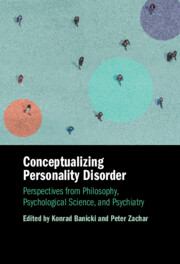 Conceptualizing Personality Disorder
Conceptualizing Personality Disorder Book contents
- Conceptualizing Personality Disorder
- Conceptualizing Personality Disorder
- Copyright page
- Contents
- Figures
- Tables
- Contributors
- Introduction
- Part I Historical Perspectives
- Part II Contemporary Approaches to Traditional Conceptual Perspectives
- 4 The Psychodynamic Core of Personality Disorder
- 5 Multiple Roads to Pathology
- 6 A Contemporary Integrative Interpersonal Theory Formulation of Self and Social Pathology
- 7 The Inflexible Self and Lived Time
- 8 Psychopharmacology and Personality Disorder
- 9 When Do Personality Traits Become Pathological?
- Part III Novel Conceptual Approaches to Personality Disorder
- Part IV Exploring Negative Consequences of Diagnosing Personality Disorder
- Part V Perspectives on Borderline and Narcissistic Personality
- Index
- References
9 - When Do Personality Traits Become Pathological?
An Epistemological and Evolutionary View
from Part II - Contemporary Approaches to Traditional Conceptual Perspectives
Published online by Cambridge University Press: 25 June 2025
- Conceptualizing Personality Disorder
- Conceptualizing Personality Disorder
- Copyright page
- Contents
- Figures
- Tables
- Contributors
- Introduction
- Part I Historical Perspectives
- Part II Contemporary Approaches to Traditional Conceptual Perspectives
- 4 The Psychodynamic Core of Personality Disorder
- 5 Multiple Roads to Pathology
- 6 A Contemporary Integrative Interpersonal Theory Formulation of Self and Social Pathology
- 7 The Inflexible Self and Lived Time
- 8 Psychopharmacology and Personality Disorder
- 9 When Do Personality Traits Become Pathological?
- Part III Novel Conceptual Approaches to Personality Disorder
- Part IV Exploring Negative Consequences of Diagnosing Personality Disorder
- Part V Perspectives on Borderline and Narcissistic Personality
- Index
- References
Summary
“Personality” is considered as a set of individual characteristics and behavioral dispositions based on both temperamental (partially genetic-driven) and developmental (partially culture-driven) components that are relatively stable across time and context. We suggest that these two intertwined components progressively shape autopoietic processes operating at an individual and a social level in accordance with the theory of evolution and its application to human behavior. We discuss existing evidence linking personality traits to the manifestations of personality disorders and diverse forms of psychopathology. Particular attention is dedicated to the evolutionary concept referred to as Life History Theory, considering its utility in predicting the development of personality traits. We also emphasize the need to explore sources of critique and further research, suggesting that a multifaceted approach to the understanding of personality dimensions is crucial.
Keywords
Information
- Type
- Chapter
- Information
- Conceptualizing Personality DisorderPerspectives from Philosophy, Psychological Science, and Psychiatry, pp. 160 - 178Publisher: Cambridge University PressPrint publication year: 2025